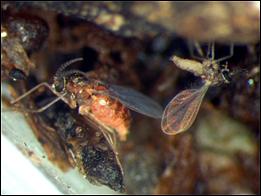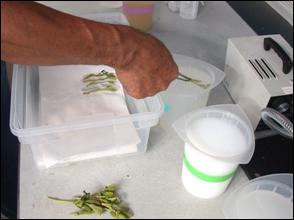Evaluation Of Novel Mode Of Action Insecticides To Control Blueberry Gall Midge In Blueberry, 2008
L. K. Tanigoshi, B. S. Gerdeman and G. Hollis Spitler
Washington State University
Mount Vernon Northwestern Research and Extension Center
Mount Vernon, WA 98273-4768
Blueberry gall midge (BGM), Dasineura oxycoccana(Johnson) field trial.
 A mixed stage distribution of the last generation of blueberry gall midge were targeted with systemic/contact insecticides to control the prepupal stage before they drop to the ground to overwinter in the soil as pupae. The treatments listed below were applied on a 5-6 year old ‘Duke’ field in Lynden (Boundary Road), WA on eight plants per treatment with a two quart hand sprayer with an adjustable fine mist nozzle on 26 September. Shoots selectively treated contained mostly vegetative buds with a third being floral buds. Bayer CropScience’s experimental spirotetramat (Movento™ @ 0.12 lb(AI)/acre ) is a systemic foliar product shown to provide long-term control of sucking pest with a unique mode of action classified as a lipid biosynthesis inhibitor. DuPont’s experimental DPX-HGW86 10SE (Cyazypyr™ @ 13.5 fl oz/acre) is formulated as a SE (suspo emulsion). It is translaminar via foliar application and systemic via root uptake (drip irrigation application) and broad spectrum. Cyazypyr is a member of a new chemical class (IRAC) called diamides that modulate ryanodine receptors in muscles cells causing uncontrolled release and depletion of Ca2+. Dow’s spinetoram (Delegate WG @0.09 lb(AI)/acre) will replace Success™ with its genetically modified spinosyn J and L that is labeled as a stomach suppressor of blueberry gall midge. Bacillus thuringiensis israelensis (Gnatrol WDG @ 0.26 oz/gal) is a biological larvicide known to control fungus gnats and mushroom flies. United Phosphorus’ acetamiprid (Assail 70WP at 0.083 and 0.1 lb(AI)/acre) was our standard.
A mixed stage distribution of the last generation of blueberry gall midge were targeted with systemic/contact insecticides to control the prepupal stage before they drop to the ground to overwinter in the soil as pupae. The treatments listed below were applied on a 5-6 year old ‘Duke’ field in Lynden (Boundary Road), WA on eight plants per treatment with a two quart hand sprayer with an adjustable fine mist nozzle on 26 September. Shoots selectively treated contained mostly vegetative buds with a third being floral buds. Bayer CropScience’s experimental spirotetramat (Movento™ @ 0.12 lb(AI)/acre ) is a systemic foliar product shown to provide long-term control of sucking pest with a unique mode of action classified as a lipid biosynthesis inhibitor. DuPont’s experimental DPX-HGW86 10SE (Cyazypyr™ @ 13.5 fl oz/acre) is formulated as a SE (suspo emulsion). It is translaminar via foliar application and systemic via root uptake (drip irrigation application) and broad spectrum. Cyazypyr is a member of a new chemical class (IRAC) called diamides that modulate ryanodine receptors in muscles cells causing uncontrolled release and depletion of Ca2+. Dow’s spinetoram (Delegate WG @0.09 lb(AI)/acre) will replace Success™ with its genetically modified spinosyn J and L that is labeled as a stomach suppressor of blueberry gall midge. Bacillus thuringiensis israelensis (Gnatrol WDG @ 0.26 oz/gal) is a biological larvicide known to control fungus gnats and mushroom flies. United Phosphorus’ acetamiprid (Assail 70WP at 0.083 and 0.1 lb(AI)/acre) was our standard.
At five days posttreatment, 25 terminal buds, 2-3 inches in length per eight-plant treatment, were picked and placed in individual paper bags and held in a cooler for transport back to the lab. Each bud was examined under a stereoscopic dissecting scope and bud scales were examined with a teasing needle. Efficacy per bud was scored as dead, alive or uninfested. Percent alive for the untreated check suggests our late season field sites was infested somewhere between 30-35% (Table 1). Assail and Movento provided good systemic control of BGM larvae that are nearly unreachable in tight floral and vegetative buds undergoing fall dormancy. The contact acting Delegate showed 60% mortality of infested and tightly maturing fall buds, comparable to the activity observed for the 2-way systemicity and specificity of Movento. Given the late season conditions for this trial designed to apply systemic/contact products for larvae known to be present inside the buds, HGW86 showed poor control. These lower than expected results after 5 days may have been due to several factors, including inappropriate timing, choice of surfactant, rate, GPA and product activity to immatures compared to foliar applications for adults and egg.
| Treatment | lb(AI)/acre | Larval % Mortality | % Live | % Uninfested |
|---|---|---|---|---|
| 5DAT | ||||
| * Buffered to a pH of 5 or lower. | ||||
| MSO = methylated seed oil adjuvant, D-A, Dyne-Amic SL, 0.25% v/v. | ||||
| Assail 70WP | 0.08 | 72 | 0 | 28 |
| Assail 70WP | 0.10 | 52 | 0 | 48 |
| Delegate WG + MSO | 0.09 | 60 | 4 | 36 |
| Gnatrol WDG | 0.26 oz/gal | 16 | 20 | 64 |
| HGW86 10SE* + MSO | 13.5 fl oz | 25 | 8 | 68 |
| Movento 240SC + D-A | 0.12 | 60 | 0 | 40 |
| Untreated check | 8 | 32 | 60 | |
Blueberry gall midge bioassay.
 Two collections of blueberry buds were made on 11 September and 18 September in the Lynden, WA field described above. The field was infested with a late season population of BGM larvae. We selectively picked terminals that we judged to be infested before they were dipped for 5 seconds in the same insecticides and rates used for the field trial. Within 24 hours, seven, two sets of 20 terminal buds each were individually dipped in their respective treatments and placed on paper toweling lining individual 14 liter polypropylene boxes (Table 2 & Table 3). For test 1, half of the sample was destructively sampled at 1 and 3 days posttreatment, while test 2 was destructively sampled at 3 and 5 days posttreatment. Results were variable given the objective to control maturing larvae inside maturing floral and vegetative buds. Dissecting each bud and scoring buds as containing dead BGM larvae divided by total buds that were uninfested or contained live larvae calculated percent mortality.
Two collections of blueberry buds were made on 11 September and 18 September in the Lynden, WA field described above. The field was infested with a late season population of BGM larvae. We selectively picked terminals that we judged to be infested before they were dipped for 5 seconds in the same insecticides and rates used for the field trial. Within 24 hours, seven, two sets of 20 terminal buds each were individually dipped in their respective treatments and placed on paper toweling lining individual 14 liter polypropylene boxes (Table 2 & Table 3). For test 1, half of the sample was destructively sampled at 1 and 3 days posttreatment, while test 2 was destructively sampled at 3 and 5 days posttreatment. Results were variable given the objective to control maturing larvae inside maturing floral and vegetative buds. Dissecting each bud and scoring buds as containing dead BGM larvae divided by total buds that were uninfested or contained live larvae calculated percent mortality.
| Treatment | lb(AI)/acre | % Mortality | % Uninfested buds | ||
|---|---|---|---|---|---|
| 1DAT | 3DAT | 1DAT | 3DAT | ||
| * Buffered to a pH of 5 or lower. | |||||
| MSO = methylated seed oil adjuvant, D-A, Dyne-Amic SL, 0.25% v/v. | |||||
| Assail 70WP | 0.08 | 78 | 50 | 20 | 40 |
| Assail 70WP | 0.10 | 0 | 57 | 60 | 30 |
| Delegate WG + MSO | 0.09 | 0 | 20 | 60 | 50 |
| Gnatrol WDG | 0.26 oz/gal | 50 | 0 | 70 | 30 |
| HGW86 10SE* + MSO | 13.5 fl oz | 67 | 88 | 40 | 20 |
| Movento 240SC + D-A | 0.12 | 50 | 100 | 80 | 90 |
| Untreated check | 0 | 0 | 60 | 30 | |
| Treatment | lb(AI)/acre | % Mortality | % Uninfested buds | ||
|---|---|---|---|---|---|
| 3DAT | 5DAT | 3DAT | 5DAT | ||
| * Buffered to a pH of 5 or lower. | |||||
| MSO = methylated seed oil adjuvant, D-A, Dyne-Amic SL, 0.25% v/v. | |||||
| Assail 70WP | 0.08 | 33 | 83 | 10 | 40 |
| Assail 70WP | 0.10 | 89 | 88 | 10 | 20 |
| Delegate WG + MSO | 0.09 | 88 | 100 | 20 | 60 |
| Gnatrol WDG | 0.26 oz/gal | 0 | 70 | 20 | 0 |
| HGW86 10SE* + MSO | 13.5 fl oz | 25 | 88 | 20 | 20 |
| Movento 240SC + D-A | 0.12 | 86 | 100 | 30 | 10 |
| Untreated check | 0 | 0 | 20 | 0 | |
 Note percentages showing uninfested buds for each treatment and corresponding days posttreatment for 10 destructively sampled terminals. Bioassay test 1, collected on 11 September showed a trend for more uninfested buds per treatment compared with the 18 September collection. Thus the mortality of blueberry gall midge larvae per bud reported in especially test 1 may represent smaller number of larvae for a given treatment compared with test 2 mortalities. However, with two sampling dates and overlapping of days posttreatment, we feel these unreplicated treatments provide a valid assessment of their respective efficacy to mixed larval instars of the blueberry gall midge cohabitating inside maturing fall floral and vegetative buds. The translaminar Assail and HGW86 both provided good control of larvae by 5 DAT as did Delegate. Movento systemicity showed rapid mode of action within 3 DAT and 5 DAT for test 2 with a high infestation of BGM larvae. The 50% mortality reported for 1 DAT for Gnatrol in test 1 was unexpected and represented 3 larvae. However, the 70% mortality level after 5DAT shown in test 2 is realistic and suggests that the Bt toxin penetrated the more mature bud sheaths and were ingested by the larvae on 24 September. These late season treatments coupled with past field trials suggested that larvae and adult controls should be applied during blueberry’s prebloom and postbloom flushes.
Note percentages showing uninfested buds for each treatment and corresponding days posttreatment for 10 destructively sampled terminals. Bioassay test 1, collected on 11 September showed a trend for more uninfested buds per treatment compared with the 18 September collection. Thus the mortality of blueberry gall midge larvae per bud reported in especially test 1 may represent smaller number of larvae for a given treatment compared with test 2 mortalities. However, with two sampling dates and overlapping of days posttreatment, we feel these unreplicated treatments provide a valid assessment of their respective efficacy to mixed larval instars of the blueberry gall midge cohabitating inside maturing fall floral and vegetative buds. The translaminar Assail and HGW86 both provided good control of larvae by 5 DAT as did Delegate. Movento systemicity showed rapid mode of action within 3 DAT and 5 DAT for test 2 with a high infestation of BGM larvae. The 50% mortality reported for 1 DAT for Gnatrol in test 1 was unexpected and represented 3 larvae. However, the 70% mortality level after 5DAT shown in test 2 is realistic and suggests that the Bt toxin penetrated the more mature bud sheaths and were ingested by the larvae on 24 September. These late season treatments coupled with past field trials suggested that larvae and adult controls should be applied during blueberry’s prebloom and postbloom flushes.